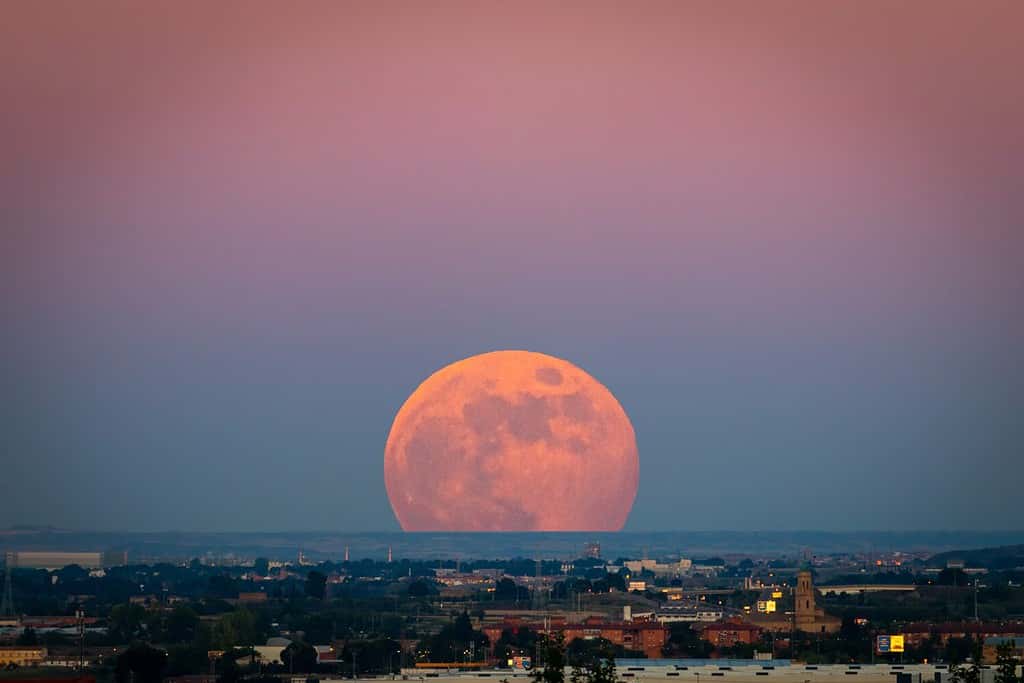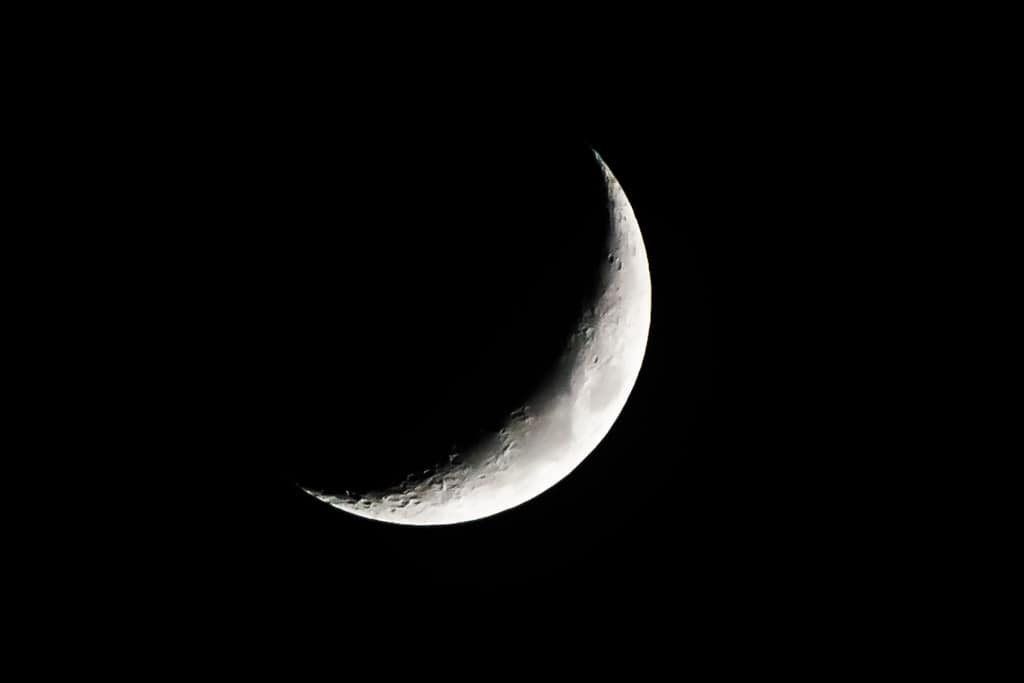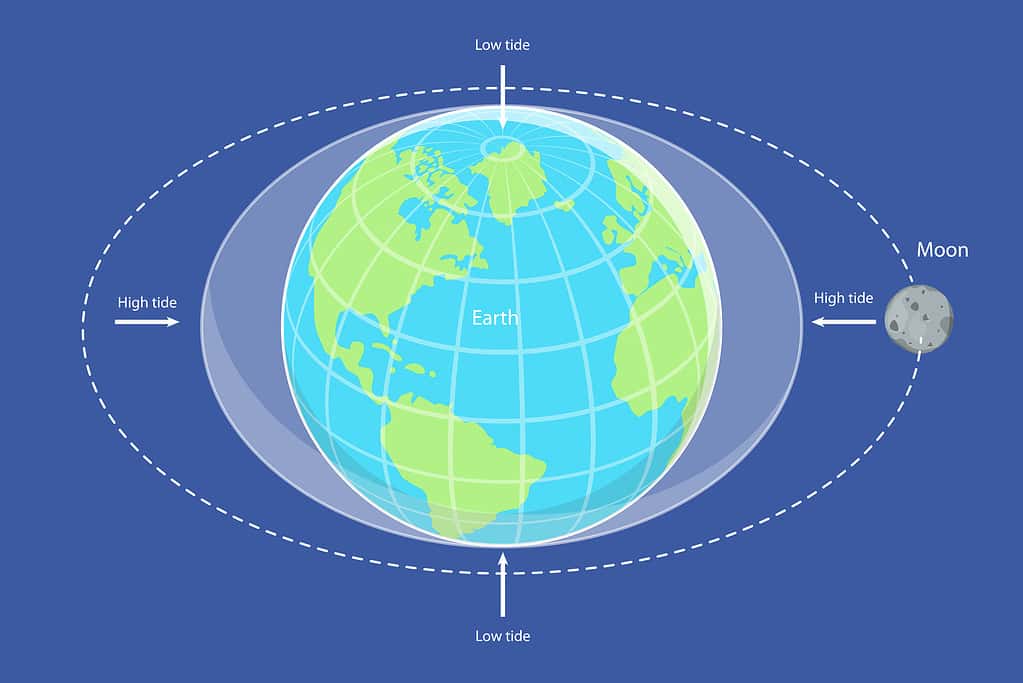Our closest celestial neighbor and the brightest object in our night sky, the moon plays an important role in making Earth a more hospitable planet for life to thrive. Without our giant lunar companion to stabilize our home planet’s tilt on its axis, dramatic climate shifts would plague the Earth. Along with maintaining the Earth’s orbital axis, the moon also greatly influences tides. This relationship creates a rhythm both animals and humans have relied on for millennia. It is the moon’s wobble, however, that may have the greatest impact in the coming years. That’s why it has recently become more important than ever to know the answer to the question — What is the moon’s wobble and how does it affect Earth?
Moon History

The moon is slowly drifting away from Earth at a rate of 1.5 inches per year.
©Ivan Morato photography/Shutterstock.com
Likely formed out of the debris from a collision by a Mars-sized body into the Earth roughly 4.5 billion years ago, the moon has a radius of about 1,080 miles. It is less than a third the width of Earth.
While the moon is currently an average of 238,855 miles from Earth, it is slowly drifting away at the rate of 1.5 inches per year. Scientists recently discovered that the moon was more than 37,000 miles closer to our planet 2.5 billion years ago.
Cosmic Coincidence
We all know the sun is the colossal heavyweight of our solar system. During a solar eclipse, however, our humble moon completely blocks out our view of the sun. How can a much smaller object cover a larger one?
In an incredible case of cosmic coincidence, even though the moon is 400 times smaller than the sun, it’s also about 400 times closer to Earth than the sun is. This means that both the sun and moon appear to be the same size viewed from Earth. As we now know that the moon is quietly drifting away from us, people in the future may not be fortunate enough to experience a total solar eclipse.
Our Moon Is Unique
Most planets have moons, but Earth’s moon is distinct because it is large compared to the size of our planet. Large satellites, as moons are often called, may be part of the equation needed to solve the riddle of what circumstances are required for life to develop.
The moon isn’t just unique in our solar system. While there is still some debate around the topic, research reveals that less than 10 percent of terrestrial planets may have a moon large enough to provide the stability required for life to develop.
The Dark Side of the Moon

Although we only ever see one face of the moon, the moon does rotate on its axis.
©Clare McEwen/Shutterstock.com
A common misconception is that the moon does not spin on its axis as it orbits Earth. This stems from the fact that we always see the same side of the moon. In another interesting coincidence, the moon spins at exactly the same rate as its orbit — one revolution every 27 days. This means that one year on the moon is equal to one day on the moon. Check out this visualization of the process from NASA.
Synchronous rotation, as the phenomenon is called, is a result of the gravitational pull between the Earth and the moon. This tug-of-war between our planet and our lunar companion slows down the Earth’s rotation, contributing in another way to making Earth more habitable. Thanks, moon!
What Is the Moon’s Wobble?
The moon’s orbit around Earth is a complicated process. There are a few ways in which the moon seems to wobble.
Wobble in the Moon’s Appearance
The first way this wobbling appears is related to the synchronous rotation of the moon. Because the moon makes an elliptical — more oval-shaped than circular — orbit around Earth, its velocity varies. This variation causes our perspective of the “light side” to appear at slightly different angles.
We actually see about 59 percent of the lunar surface over the course of its orbit, but not at the same time, giving the appearance of a rocking ship if the visualization is sped up. You can see the wobbling in this compressed video from NASA. This type of wobble does not affect the Earth as the oscillation in the moon’s orbital plane does.
Wobble in the Moon’s Orbital Plane
The plane of the Earth’s orbit around the sun is called the ecliptic. The plane of the moon’s orbit is close to the ecliptic, but not identical. Tilted by 5.1 degrees relative to the ecliptic, the moon orbits Earth for half the month above Earth’s orbital plane and for the other half below Earth’s orbital plane.
Due to the effects of the sun’s gravity, however, the moon’s orbital plane does not stay fixed in space. The moon’s orbital plane “precesses” in an 18.6-year cycle, while still maintaining the 5.1-degree tilt relative to the ecliptic. This oscillation or wobbling of the tilt of the moon’s orbital plane gradually causes the moon to rise at different points on the horizon over those 18.6 years.
The wobble of the moon’s orbit around the Earth is similar to a spinning coin slowing down before coming to rest. This oscillation is nothing new. It has been happening for billions of years. Only recently, however, has the moon’s wobble alarmed scientists.
How Does the Moon’s Wobble Affect Earth?

The gravitational pull of the sun and the moon creates the rhythm of the tides on Earth. The moon’s wobble, however, affects Earth’s tides with greater variation than the monthly cycle.
©TarikVision/iStock via Getty Images
The wobble in the moon’s orbit has always played a role in the tides here on Earth. It is the gravitational pull of the moon and the sun that creates the rhythm of the tides as we know them. Because the sun is 390 times further from the Earth than the moon, however, the sun has only half of the moon’s tide-generating force.
While the monthly orbit of the moon creates our familiar rhythm of the tides with higher ranges in the tides occurring when the moon is closest to the Earth, it is the wobble that has scientists concerned. A study published in the journal Nature Climate Change in 2021 on high-tide flooding predicts that in the mid-2023s U.S. coastal regions will experience catastrophic flooding due to the effects of the moon’s wobble.
It is the moon’s slow wobble over time, or its positioning relative to the Earth’s orbit, that causes a shift in the tidal amplitude on Earth.
CoastalReview.org reports, “Although the wobble is imperceptible to people, what is important is that when the moon is on the lower part of the wobble, it pulls the tides down with it, meaning that high tide would be lower. Then, when it moves to the higher part of the wobble, it will do the reverse — pull the high tide higher than usual.”
Combination of Global Warming and the Moon’s Wobble
This phenomenon has been happening for as long as humans have been on Earth. The problem, scientists say, is that sea-level rise caused by global warming will amplify the effects of the lunar cyclical increase in high tides.
By the mid-2030s, the lunar cycle will be set to create higher high tides and lower low tides for the approximately nine years that make up half of the 18.6-year wobble cycle. While half of the lunar cycle counteracts the effect of sea-level rise on high tides, coastal cities will need to prepare for the flooding set to come from a combination of sea-level rise and the tide-amplifying part of the lunar cycle.
To see a visualization of how tides may rise in the future, check out NASA’s Sea Level Projection Tool.
The photo featured at the top of this post is © Jitendra Jadhav/iStock via Getty Images
Thank you for reading! Have some feedback for us? Contact the AZ Animals editorial team.







